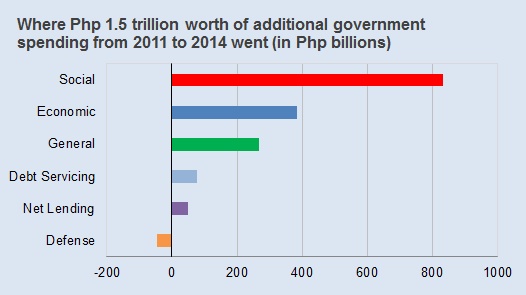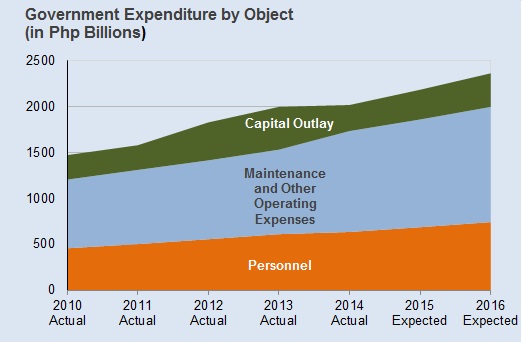Part of an #Election2016 series called “What’s at Stake?”
The next president will inherit a budget of 3 trillion pesos, double what the current president inherited in 2010. From 2011 to 2014, actual spending under the Aquino administration rose an average of 6.8% a year reaching Php 1.98 trillion, up from one-and-a-half trillion pesos in 2010. Actual revenues rose from Php 1.2 trillion to Php 1.9 trillion during this time, averaging a growth of 12.1% a year.
As a consequence of the faster growth of revenues, the deficit shrank from Php 345 billion in 2010 (about 3.5% of GDP) to Php 73 billion in 2014 (0.6% of GDP). This shrinking of the deficit was a result of the administration’s policy of ‘fiscal consolidation’ or spending less than the appropriations approved by congress. The programmed deficits of 2% of GDP in the budget papers amounts to Php 284 billion in 2015, Php 309 billion in 2016 and Php 340 billion in 2017.
If however revenues and disbursements continue to grow at the same rate in the years 2015 to 2017 as they did in the previous four years, revenues would only reach Php 2.7 trillion in 2017 instead of the Php 3 trillion projected. Disbursements would only total Php 2.4 trillion, not Php 3.4 trillion by next year. The government will actually start to produce surpluses of Php 23 billion in 2015, Php 138 billion in 2016, and Php 275 billion in 2017 (see chart below)!

This represents a decision point for the new government. Will it bank these surpluses, use them to pay down our national debt (which stood at Php 5.9 trillion at the end of 2015, or about 42% of GDP compared to Php 4.7 trillion at the end of 2010, or about 52% of GDP). Will it use them to lower taxes for individuals and corporations, as some have advocated? Will the next administration be able to increase its spending capacity? Is it wise to be producing surpluses at this stage of our development? These are some of the “problems” which the next president will inherit.
Spending by Sector
The national government spent an additional Php 1.5 trillion pesos from 2011 to 2014, above its spending level in 2010. Over half of that amount (Php 831 billion) was spent on social services (health, education, social welfare, land distribution, and housing). About a quarter (Php 384 billion) went to economic services (agriculture, tourism, power, water, flood control, transport and roads). An additional Php 268 billion was spent on general services (public order and safety), while defense spending contracted by Php 45 billion during this time. Debt servicing increased by Php 76 billion (see chart below).

If spending continues to grow at 6.8% a year on average from 2015 onwards, by 2017 (and every year thereafter) there would be about Php 150-200 billion in extra funds that would be available for any of these services. This amounts to Php 3 trillion of additional spending, over the six year life of the next administration. This is another decision point. It will be up to the next administration to decide what to spend on. How much of it should be used for social spending? How much for economic infrastructure? How much for defense and public safety?
Spending by Object
Personnel expenses rose from Php 458 billion in 2010 to Php 636 billion in 2014, an increase of 39%. Maintenance and other operating expenses (MOOE) rose from Php 748 billion to Php 1.1 trillion in that period, an increase of 47%. Capital outlays were lumpy. It stayed virtually the same from 2010 to 2011 at roughly Php 268 billion, and grew to Php 413 billion in 2012 with the start of the Disbursement Acceleration Program (DAP) and 467 billion in 2013 (an election year). In 2014 it fell to Php 285 billion when DAP was declared unconstitutional (see Fig. 3).

Of the Php 1.5 trillion in additional spending from 2011 to 2014, 31% went to personnel expenses (Php 476 billion), 45% went to MOOE (Php 693 billion), and 24% went to capital outlay (Php 365 billion). If these relationships continue to hold, that would mean by 2017, personnel expense could increase to Php 802 billion, MOOE to Php 1.3 trillion, and capital outlay to Php 412 billion. With Php 200 billion in additional funds available each year an extra Php 60 billion would be spent on personnel, an extra Php 88 billion on MOOE, and an extra Php 46 billion on capital outlay.
Of course, none of this is set in stone. It would be up to the next administration to apportion the increase of expenditure, but this demonstrates the increased spending capacity of the national government to upgrade and retool itself. It would certainly be possible to achieve an actual (as opposed to budgeted) spend on infrastructure worth 5% of GDP in a few years’ time.
About The Author

Emmanuel Doy Santos
The author works as a development consultant and policy analyst in Adelaide, South Australia and Manila, Philippines. He is also the founder of the 2Klas Program, which equips inner city youth in Metro Manila with 21st Century skills. He has a Facebook page @CuspPH and tweets as @cusp_ph. He blogs and hosts a podcast on htttps://cusp-ph.blogspot.com.
The Next President’s Budget
Part of an #Election2016 series called “What’s at Stake?”
The next president will inherit a budget of 3 trillion pesos, double what the current president inherited in 2010. From 2011 to 2014, actual spending under the Aquino administration rose an average of 6.8% a year reaching Php 1.98 trillion, up from one-and-a-half trillion pesos in 2010. Actual revenues rose from Php 1.2 trillion to Php 1.9 trillion during this time, averaging a growth of 12.1% a year.
As a consequence of the faster growth of revenues, the deficit shrank from Php 345 billion in 2010 (about 3.5% of GDP) to Php 73 billion in 2014 (0.6% of GDP). This shrinking of the deficit was a result of the administration’s policy of ‘fiscal consolidation’ or spending less than the appropriations approved by congress. The programmed deficits of 2% of GDP in the budget papers amounts to Php 284 billion in 2015, Php 309 billion in 2016 and Php 340 billion in 2017.
If however revenues and disbursements continue to grow at the same rate in the years 2015 to 2017 as they did in the previous four years, revenues would only reach Php 2.7 trillion in 2017 instead of the Php 3 trillion projected. Disbursements would only total Php 2.4 trillion, not Php 3.4 trillion by next year. The government will actually start to produce surpluses of Php 23 billion in 2015, Php 138 billion in 2016, and Php 275 billion in 2017 (see chart below)!

This represents a decision point for the new government. Will it bank these surpluses, use them to pay down our national debt (which stood at Php 5.9 trillion at the end of 2015, or about 42% of GDP compared to Php 4.7 trillion at the end of 2010, or about 52% of GDP). Will it use them to lower taxes for individuals and corporations, as some have advocated? Will the next administration be able to increase its spending capacity? Is it wise to be producing surpluses at this stage of our development? These are some of the “problems” which the next president will inherit.
Spending by Sector

The national government spent an additional Php 1.5 trillion pesos from 2011 to 2014, above its spending level in 2010. Over half of that amount (Php 831 billion) was spent on social services (health, education, social welfare, land distribution, and housing). About a quarter (Php 384 billion) went to economic services (agriculture, tourism, power, water, flood control, transport and roads). An additional Php 268 billion was spent on general services (public order and safety), while defense spending contracted by Php 45 billion during this time. Debt servicing increased by Php 76 billion (see chart below).
If spending continues to grow at 6.8% a year on average from 2015 onwards, by 2017 (and every year thereafter) there would be about Php 150-200 billion in extra funds that would be available for any of these services. This amounts to Php 3 trillion of additional spending, over the six year life of the next administration. This is another decision point. It will be up to the next administration to decide what to spend on. How much of it should be used for social spending? How much for economic infrastructure? How much for defense and public safety?
Spending by Object

Personnel expenses rose from Php 458 billion in 2010 to Php 636 billion in 2014, an increase of 39%. Maintenance and other operating expenses (MOOE) rose from Php 748 billion to Php 1.1 trillion in that period, an increase of 47%. Capital outlays were lumpy. It stayed virtually the same from 2010 to 2011 at roughly Php 268 billion, and grew to Php 413 billion in 2012 with the start of the Disbursement Acceleration Program (DAP) and 467 billion in 2013 (an election year). In 2014 it fell to Php 285 billion when DAP was declared unconstitutional (see Fig. 3).
Of the Php 1.5 trillion in additional spending from 2011 to 2014, 31% went to personnel expenses (Php 476 billion), 45% went to MOOE (Php 693 billion), and 24% went to capital outlay (Php 365 billion). If these relationships continue to hold, that would mean by 2017, personnel expense could increase to Php 802 billion, MOOE to Php 1.3 trillion, and capital outlay to Php 412 billion. With Php 200 billion in additional funds available each year an extra Php 60 billion would be spent on personnel, an extra Php 88 billion on MOOE, and an extra Php 46 billion on capital outlay.
Of course, none of this is set in stone. It would be up to the next administration to apportion the increase of expenditure, but this demonstrates the increased spending capacity of the national government to upgrade and retool itself. It would certainly be possible to achieve an actual (as opposed to budgeted) spend on infrastructure worth 5% of GDP in a few years’ time.
Related Posts
“What alternatives are left to the Sultanate after March 1, 2013?” – Yolanda Ortega-Stern
Aquino + New PNP Chief = Alternative truths on metro traffic and Mamasapano case
The Rise of Tough Leaders and Their Populist Agenda
About The Author
Emmanuel Doy Santos
The author works as a development consultant and policy analyst in Adelaide, South Australia and Manila, Philippines. He is also the founder of the 2Klas Program, which equips inner city youth in Metro Manila with 21st Century skills. He has a Facebook page @CuspPH and tweets as @cusp_ph. He blogs and hosts a podcast on htttps://cusp-ph.blogspot.com.